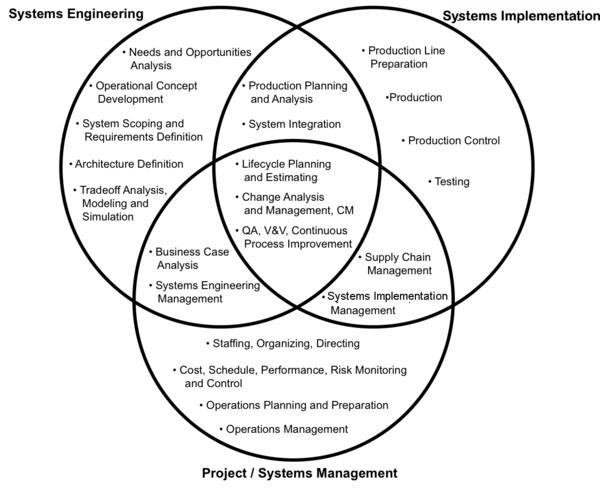Difference between revisions of "Systems Engineering Management"
m (Text replacement - "<center>'''SEBoK v. 2.0, released 1 June 2019'''</center>" to "<center>'''SEBoK v. 2.1, released 31 October 2019'''</center>") |
m (Text replacement - "'''SEBoK v. 2.1, released 31 October 2019'''" to "'''SEBoK v. 2.2, released 15 May 2020'''") |
||
| Line 42: | Line 42: | ||
<center>[[Logistics|< Previous Article]] | [[Systems Engineering and Management|Parent Article]] | [[Planning|Next Article >]]</center> | <center>[[Logistics|< Previous Article]] | [[Systems Engineering and Management|Parent Article]] | [[Planning|Next Article >]]</center> | ||
| − | <center>'''SEBoK v. 2. | + | <center>'''SEBoK v. 2.2, released 15 May 2020'''</center> |
[[Category: Part 3]][[Category:Knowledge Area]] | [[Category: Part 3]][[Category:Knowledge Area]] | ||
Revision as of 08:00, 13 May 2020
Lead Authors: Ray Madachy, Garry Roedler
This knowledge area is about managing the resources and assets allocated to perform systems engineering, often in the context of a project or a service, but sometimes in the context of a less well-defined activity. Systems engineering management is distinguished from general project management by its focus on the technical or engineering aspects of a project. SEM also encompasses exploratory research and development (R&D) activities at the enterprise level in commercial or government operations.
Topics
Each part of the SEBoK is composed of knowledge areas (KAs). Each KA groups topics together around a theme related to the overall subject of the part. This KA contains the following topics:
- Planning
- Assessment and Control
- Risk Management
- Measurement
- Decision Management
- Configuration Management
- Information Management
- Quality Management
See the article Matrix of Implementation Examples for a mapping of case studies and vignettes included in Part 7 to topics covered in Part 3.
Discussion
Implementing systems engineering (SE) requires the coordination of technical and managerial endeavors. Success with the technical is not possible in the absence of the managerial. Management provides the planning, organizational structure, collaborative environment, and program controls to ensure that stakeholder needs are met.
The Venn diagram below provides some context for thinking about SEM. It shows that some functions are managed within the SE function, while others are managed in collaboration with the management of systems implementation and with overall project and systems management.
There is no one-size-fits-all way to define the details of where SEM functions are performed. An in-company SE organization does not run its own accounting system, but relies on the corporate management organization for this aspect of SEM. A company performing only SE does include the accounting functions as part of SEM. In all cases, the managers of the SE function must be actively involved in the management of all the activities within the SE system boundary, including working out what collaborative arrangements best fit their situation. They must also remain aware of management events in their environment outside the system boundary that may affect their ability to perform. Part 6 of the SEBoK includes relevant knowledge areas for collaborative management, including Systems Engineering and Software Engineering, Systems Engineering and Project Management, Systems Engineering and Industrial Engineering, Systems Engineering and Procurement/Acquisition, and Systems Engineering and Specialty Engineering.
References
Works Cited
None.
Primary References
Blanchard, B.S. 2004. Systems Engineering Management, 3rd ed. New York, NY, USA: John Wiley & Sons Inc.
Sage, A.P. and W. Rouse. 2009. Handbook of Systems Engineering and Management, 2nd Ed. Hoboken, NJ, USA: John Wiley and Sons.
Additional References
None.
